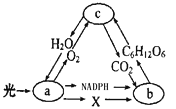问题
单项选择题
如图表示绿色植物体内某些代谢过程中物质的变化,A.B.c分别表示不同的代谢过程。以下表述正确的是()

A.X代表的物质从叶绿体的基粒移向叶绿体的基质
B.b在叶绿体内的囊状结构薄膜上进行
C.a中产生的O2参与c的第二阶段
D.水参与c中第三阶段的反应
答案
参考答案:A
解析:a是光和作用的光反应,产生还原氢和ATP给b光合作用暗反应生成水,X是ATP,由叶绿体的基粒移向叶绿体的基质,A正确;光反应在类囊体薄膜上进行,而暗反应在叶绿体基质中进行,B错。b产生葡萄糖给c,由此可推出c是呼吸作用,水参与第二阶段反应,而氧气参与第三阶段反应还产生12个水分子,这些水分子可以提供给叶绿体进行光合作用生成氧气,故CD错。考点:本题考查光合作用的基本过程、呼吸作用的相关知识,意在考查考生能理解所学知识的要点,把握知识间的内在联系,形成知识的网络结构的能力。
